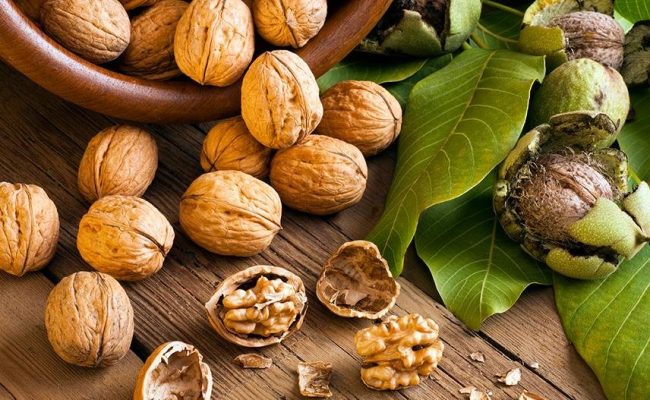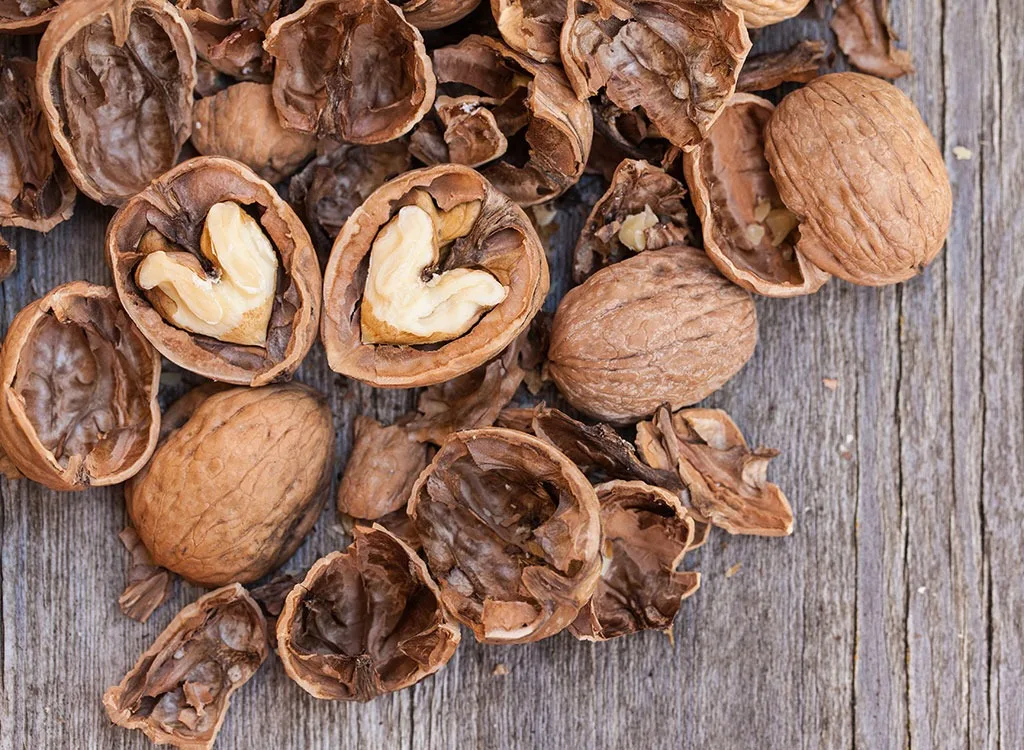Walnuts: Nutritional Value / 5 Walnuts

5 medium walnuts (21 gr. Peeled)
Carbohydrates
2.78 gr
1.1 %
Sugars
0.52 gr
1 %
Fiber
1.35 gr
5.4 %
Protein
3.08 gr
2.1 %
Total Fat
13.3 gr
29.6 %
Saturated
1.24 gr
13.8 %
Monocature
1.8 gr
7.5%
Polyunsaturated
9.5 gr
79.2%
Αναλογία Μακροθρεπτικών
Energy / 5 nuts
Daily Coverage for diet 2000kcal *
Calories
132 kcal
6.6 %
Vitamins, Minerals & amp; Trace elements / 5 nuts
Manganese Women 🚺
0.69 mg
38.3 %
Copper 🚹🚺
0.321 mg
35.8 %
Manganese Men 🚹
0.68 mg
30 %
Phosphorus 🚺 🚹>
70 mg
10 %
Magnesium Women 🚺
31.9 mg
10 %
Vitamin B6 🚺 🚹
0.108 mg
8.3 %
Zinc Women 🚺
0.62 mg
7.8 %
Magnesium Men 🚹
31.9 mg
7.6 %
Iron Men 🚹
0.58 mg
7.3 %
Thiamine B1 Women🚺
0.069 mg
6.3 %
Thiamine Men 🚹
0.069 mg
5.8 %
How do 5 walnuts a day meet our fatty acid needs?

Walnuts contain a high percentage of unsaturated fatty acids which are also known as “good fats” with proven and multiple benefits for our health. Our body has the ability to synthesize all fatty acids (ω3, ω6, ω9, and so on) except two, α-linolenic acid and linoleic acid which are the essential fatty acids -Essential Fatty Acids (EFAs ). They are the only fatty acids we need to take care of receiving from our diet since from these two our body has the ability to synthesize all the other fatty acids. What makes walnut stand out from all the other nuts is that it contains both essential fatty acids in sufficient quantities.
Specifically:
5 nuts (132 kcal) give us:
The benefits and properties of walnuts for our health

They lower LDL cholesterol
In a recent study that combined data from 26 previous trials in more than 1,000 people. concluded that people who ate nuts in their diet , showed compared to the rest:
- lower total cholesterol (by about 7 mg / dL, representing 3% greater reduction)
- lower LDL cholesterol (approximately 5.5 mg / dL, 4% greater reduction)
- lower triglycerides < / (approximately 5.7 mg / dL, 5.5% greater reduction)
- lower apoprotein B (a protein associated with cardiovascular disease) by approximately 4 mg / dL

They have anti-inflammatory properties
In a large 2-year study conducted on 600 adults around 60-70 years lasting for two years, it was observed that adults who consumed 30-60 g of walnuts per day showed reduced inflammation. Those who ate walnuts had a significant reduction in inflammation, measured by the concentration of known inflammatory markers in the blood, which decreased by up to 11.5%.

They have antioxidant properties
A new scientific study places walnuts at No. 1 among healthy foods, concluding that walnuts have a combination of more healthy and higher quality antioxidants than any other nut. A handful of walnuts contains almost twice as much antioxidants as an equivalent amount of any other commonly consumed nut.

They protect cardiovascular health
Cardiometabolic risk factors that develop in middle age (hypertension, obesity, hyperlipidemia) are also considered potential risk factors for cognitive impairment and dementia. Several studies have shown that walnuts in the diet can reduce the risk of heart disease by improving various cardiometabolic risk factors. A diet rich in walnuts can lower total cholesterol and LDL (bad cholesterol), increase HDL (good cholesterol), lower blood pressure, inflammation and plaque formation.
Why walnuts are at the top of the list of antioxidant foods
Several studies suggest that walnuts (Juglans regia L.) may reduce the risk of age-related diseases due to their antioxidant and anti-inflammatory properties. Walnuts are high in antioxidants (3.68 mmol / oz), including flavonoids, phenolic acid (ellagic acid), melatonin, folic acid, tocopherol gamma (vitamin E), selenium, yuglone and proanthocyanidins. In addition, walnuts contain a high amount of n-3 α-linolenic acid (ALA), a plant-derived omega-3 fatty acid that has an extremely strong anti-inflammatory effect. Walnuts also provide protein (4 g / oz), fiber (2 g / oz), phosphorus (10% daily value) and magnesium (11% daily value).
Out of 1113 different foods tested for their antioxidant content, walnuts were ranked second. Among nuts, walnuts have the best antioxidant effectiveness, as evidenced by the fact that walnuts have the highest phenolic content, followed by almonds and cashews, followed by raisins. Another report showed that 50 grams of walnuts have a significantly higher phenolic content compared to a 220ml glass of apple juice, a 220ml glass of red wine or a bar of milk chocolate.
Although most nuts contain monounsaturated fats, only nuts contain mainly polyunsaturated fats (13 g of 18 g of total fat per 28 g of nuts), of which ALA is 2.5 g. ALA is the precursor of eicosapentaenoic acid (EPA) and eicosodiohexanoic acid (DHA), which are known to have anti-inflammatory effects. Studies have shown that ALA inhibits inflammation by inhibiting the production of compounds responsible for inflammation (eg iNOS, NO, COX-2 and inflammatory cytokines (IL-1β, IL-6, TNF-α)
Why walnuts are the guardian 😇 angel of our brain:

Oxidative stress and inflammation play an important role in the aging process of the brain, in mild cognitive impairment (MCI), in dementia and in many age-related diseases. Walnuts have multiple components with antioxidant and anti-inflammatory action, which can have cumulative or synergistic effects in suppressing inflammation and oxidative damage. Studies have shown that walnuts reduce oxidative stress not only by reducing free radical levels but also by boosting antioxidant defenses, thus reducing oxidative damage to lipids and proteins.
Essential data from animal and human studies suggest that eating walnuts (30-60 g per day) may improve cognitive function and also reduce the risk of other diseases, such as cardiovascular disease, depression, and type 2 diabetes, which is factors. risk of developing dementia. Studies in mice have clearly shown that long-term supplementation with walnuts in the diet can (a) significantly improve memory, learning skills, motor coordination, and stress-related behavior; and (b) reduce oxidative stress; and cell death.
Together, these reports suggest that early and long-term nutritional intervention with walnuts may have beneficial effects on maintaining cognitive function and protecting against age-related cognitive impairment by delaying the onset or slowing of cognitive impairment and cognitive impairment. .
Sources and References
- Harvard Health Publishing- Health benefits of walnuts
- Study shows walnuts may have anti-inflammatory effects that reduce risk of heart disease-eurekalert
- Walnuts are top nut for heart-healthy antioxidants-ACS Chemistry for life
- Chauhan A, Chauhan V. Beneficial Effects of Walnuts on Cognition and Brain Health. Nutrients. 2020;12(2):550. Published 2020 Feb 20
